#lentils market
Explore tagged Tumblr posts
Text
hold on i actually had snert now that i remember when i went to the netherlands lol it was tasty
3 notes
·
View notes
Text
i was wrong! im getting sick. just in time.
#tütensuppe#i rarely get sick bc i usually wear my mask in public#but i guess i was out in the cold dressed too lightly for a bit too long last monday#(little trip with my work team to the christmas market. i spent the time cold and depressed)#(since i dont drink alcohol or hot chocolate the only thing i had to warm up was a little bowl of lentil soup)
0 notes
Text
United States hummus market size reached USD 2.9 Billion in 2024. Looking forward, IMARC Group expects the market to reach USD 8.5 Billion by 2033, exhibiting a growth rate (CAGR) of 12.9% during 2025-2033. The increasing demand for a healthy substitute for creamy salad dressings, mayonnaise, sour cream, ranch, and other condiments is primarily driving the market growth.
#United States Hummus Market Report by Type (Classic#Lentil#Edamame#Garlic#Black#White#and Others)#Packaging Type (Tubs/Cups#Jars/Bottles#Distribution Channel (Convenience Stores#Supermarkets and Hypermarkets#Online Stores#and Region 2025-2033
0 notes
Text
Lentil Protein Market Size, Share, Trends, Growth Opportunities and Competitive Outlook
Lentil Protein Market research report has been prepared with the systematic gathering and evaluation of market information for industry which is presented in a form that explains various facts and figures to the business. A comprehensive analysis of the market structure along with the forecast of the various segments and sub-segments of the market have been delivered through Lentil Protein market report. Furthermore, the report also illustrates major prime vendors, associated with their valuable share, value, capacity, company profiles and essential shares engaged by each company.
The overall Lentil Protein market report is classified by the primitive players, application, types and geographical areas. The report contains thorough description, competitive scenario, wide product portfolio of key vendors and business strategy adopted by competitors along with their SWOT analysis and porter's five force analysis. The wide ranging market report performs geographical analysis for the major areas such as North America, China, Europe, Southeast Asia, Japan, and India, with respect to the production, price, revenue and market share for top manufacturers. Lentil Protein market research report not only saves precious time but also add credibility to the work.
Access Full 350 Pages PDF Report @
Data Bridge Market Research analyses that the lentil protein market was valued at USD 117.38 million in 2021 and is expected to reach the value of USD 212.48 million by 2029, at a CAGR of 7.70% during the forecast period of 2022-2029. In addition to the market insights such as market value, growth rate, market segments, geographical coverage, market players, and market scenario, the market report curated by the Data Bridge Market Research team includes in-depth expert analysis, import/export analysis, pricing analysis, production consumption analysis, patent analysis and consumer behaviour.
Global Lentil Protein Market survey report analyses the general market conditions such as product price, profit, capacity, production, supply, demand, and market growth rate which supports businesses on deciding upon several strategies. Furthermore, big sample sizes have been utilized for the data collection in this business report which suits the necessities of small, medium as well as large size of businesses. The report explains the moves of top market players and brands that range from developments, products launches, acquisitions, mergers, joint ventures, trending innovation and business policies.
The report provides insights on the following pointers:
Market Penetration: Comprehensive information on the product portfolios of the top players in the Lentil Protein Market.
Product Development/Innovation: Detailed insights on the upcoming technologies, R&D activities, and product launches in the market.
Competitive Assessment: In-depth assessment of the market strategies, geographic and business segments of the leading players in the market.
Market Development: Comprehensive information about emerging markets. This report analyzes the market for various segments across geographies.
Market Diversification: Exhaustive information about new products, untapped geographies, recent developments, and investments in the Lentil Protein Market.
The following are the regions covered in this report.
North America [U.S., Canada, Mexico]
Europe [Germany, UK, France, Italy, Rest of Europe]
Asia-Pacific [China, India, Japan, South Korea, Southeast Asia, Australia, Rest of Asia Pacific]
South America [Brazil, Argentina, Rest of Latin America]
The Middle East & Africa [GCC, North Africa, South Africa, Rest of the Middle East and Africa]
Some of the major players operating in the lentil protein market are:
Glanbia plc. (Ireland)
Now Health Group, Inc. (U.S.)
Nutiva Inc (U.S.)
The Simply Good Food Co (U.S.)
Iovate Health Sciences International Inc. (Canada)
MusclePharm Corporation (U.S.)
Kerry Group Plc (Ireland)
CytoSport, Inc. (U.S.)
The Nature's Bounty Co. (U.S.)
Reliance Vitamin Company, Inc. (U.S.)
Herbalife Nutrition, Inc. (U.S.)
Danone SA (France)
General Nutrition Centers (GNC) Holdings, Inc. (U.S.)
Orgain Inc. (U.S.)
True Nutrition (U.S.)
Browse Trending Reports:
Natural Sugar Substitute Market
Lentil Protein Market
Marine Ingredients Market
Grassfed Meat Market
Us Uk And Germany Coffee Creamer Market
About Data Bridge Market Research:
Data Bridge set forth itself as an unconventional and neoteric Market research and consulting firm with unparalleled level of resilience and integrated approaches. We are determined to unearth the best market opportunities and foster efficient information for your business to thrive in the market. Data Bridge endeavors to provide appropriate solutions to the complex business challenges and initiates an effortless decision-making process.
Contact Us:
Data Bridge Market Research
US: +1 888 387 2818
UK: +44 208 089 1725
Hong Kong: +852 8192 7475
Email: [email protected]
#Lentil Protein Market Size#Share#Trends#Growth Opportunities and Competitive Outlook#market report#market share#market size#marketresearch#market analysis#market trends#market research#markettrends
1 note
·
View note
Text

Full tweet:
🚨🚨 In the space of 2 weeks we’ve gone from a pilot project that involved my cousin making and distributing one pot of fortified stew a day to a fully fledged soup kitchen with 10 volunteers that feeds 160 families a day or roughly 800 hungry people daily, in Omdurman #Sudan
To do this we’ve cut out all possible overhead costs to ensure we can feed as many people as possible
🟢Our volunteers are unpaid
🟢Our cooking utensils are borrowed
🟢The kitchens storage rooms are donated free of charge
🟢Transport of food items from the market to the kitchen is free courtesy of my Cousin’s Tuk tuk.
🟢However, in order to maintain this kitchen beyond Ramadan we need you to support this Gofundme that is now fully funding this kitchen 🙏🏽
Id: there are two photos in the tweet. The first in the tweet are of a group of men and women. The second is of stacks of backs of lentils.
11K notes
·
View notes
Text

0 notes
Link
Stay up-to-date with Global Lentils Flour Market research offered by HTF MI. Check how key trends and emerging drivers are shaping this industry growth.
0 notes
Text
So I just started reading A Court of Thorns and Roses (audiobook), and am I the only one who is wondering if the author did any research into poor subsistence living or the lives of peasants? Because wow, I know Feyre’s family used to be rich, but if that was 8 years ago and y’all are poor as dirt now, somehow in the intervening period you might have learned:
- trap lines in the winter are far superior to active hunting. It burns less calories, you can use it with fish and land animals, and it will save you from frostbite bc instead of sitting in a blind for hours, you can go to your lines at certain times and head home, or drive animals toward your lines.
- buying flower seeds - or any garden seeds - is a suckers game when you’re poor. You only really need to buy seeds once!! Once you harvest, you let stuff ‘go to seed’ and then you collect it and store it for the winter, often trading seeds with your neighbours.
- they let things actively RUN OUT before doing anything about it. That’s absolutely buckwild if you’ve ever been poor — when you’re poor, you know how to make a meal stretch, and you DO IT.
- there is hunting, but no gathering?? This family has not stored any veg for winter, but neither do they go gather mushrooms, rosehips, roots, tubers, nuts, or even fucking bark?? What happened to their cottage garden?? Was it just flowers?! Were they that rich that they don’t understand that a garden produces food? Did they close their eyes as they walked past all their peasant neighbours and their gardens? Bc that’s maybe the wildest thing I’ve seen from both a historical and a ‘grew up so close to dirt poor you couldn’t tell the difference’ perspective!
- She left a whole ass Giant wolf carcass when her family is starving. Nah nah nah no that is the universe smiling on you when you’re subsistence! You will make a travois or somehow find a way to tie that to you and drag it along - that’s double the food, and possibly more money, because you could live off the wolf (which I assume does not taste great) and sell off some of the deer (which is delicious).
- she didn’t at least do a basic clean of her kill out in the woods?! She did not tan the hides?! Y’all, you do not want to be cleaning any kill on the kitchen table. Why? Because cleaning involves removing the intestines and stomach. That means shit and piss and food digestion in different stages, and the gases produced. You do that *outside*, typically at least close to where you made your kill, because you don’t want to have to have any…spills, and because it makes things a bit lighter to carry. Butchering? For sure do it on a table, but cleaning is an outdoor chore. Also, tanning a hide is not just skinning a creature! It’s scraping all the membranes off it, stretching and drying it, and curing the skin - sometimes with smoke, but often with a pretty gross solution (often including brain oil, and historically, I believe urine and/or feces, and other things with the right chemical components). It’s not a simple or quick task!
- soups, pottages, stews, with dried lentils, beans, or peas would have been the staple meals (depending on the climate and environment, but it feels fairly British thus far). Just having roasted venison (def not the best way to eat venison just from taste alone) would likely be a very very rare occurrence, because, as noted earlier, they’re so poor they would need to make it stretch. You would cure it or dry it or turn it into sausage. You would use it sparingly within a meal, not to serve as the whole meal.
- the market. If you were poor, you would likely be a stranger to spices, but not to salt. Salt is deeply necessary to survive in that period, as it’s one of the only ways of safely processing and storing meat with any longevity. And? If you got the money that they did while being as poor and as starving as they were? The first thing you would do — even if you were the most stupid rich person before then — is stock up your stores of dry goods! Flour, salt, honey, dried beans/peas/lentils, vegetables that store - onions, squashes, potatoes, root vegetables like carrots. It’s straight up Maslow’s Hierarchy of Needs here - you will not give a shit about a new cloak before you give a shit about saying your hunger. They are said to be ‘starving’. Sorting out your survival comes before sorting out your fashion.
Anyways, this has been me for channel 4, reporting on anachronisms and misrepresentations in fantasy fiction. More news at 10.
#which is not to say I’m not enjoying the book#though I am glad I got past the poor people stuff#because tell me you’ve never been a peasant without telling me you’ve never been a peasant#I thought a lot of this was common sense but then a lot of people don’t need sense this common I guess#but it’s a fun book so far#acotar#a court of thorns and roses
377 notes
·
View notes
Text
"birthday cake" is truly one of the most disgusting artificial flavorings to have been concocted in modern history. i would say that it's as if you were trying to recreate what tasting sugar for the first time would feel like to a 16th century rural peasant who subsisted entirely off of lentils and raw vegetables, but that would be far too innocent. this chemical compound is entirely a cynical product of marketing departments audience testing random words until they have generated a word combo that resembles a human experience, and then sputtering additive slop all over it in a pathetic bid to establish some staying power. it's like a sitcom bit where a robot asks "what if you could taste a happy memory" and then just comically combines ingredients people 'like' into a bowl until they have created an overstimulating mush, but there is no joke here. I walked past this homunculus in its many forms on the shelves of the grocery store for years and thought nothing of it. a monstrosity just sitting in the background of our daily lives. like an ad for shen yun or like. the devil. terrifying.
I had a birthday cake-flavored cake today (not to be confused with a. birthday cake. which is fine) for the first time and that shit was just 90% sugar. I couldn't even finish the singular slice that had been handed to me because the concentrated sweetness was so nauseating that I went to my room to lay down. I have a personal vendetta against whoever did this. to the world but also to me on MY SUNDAY AFTERNOON.
88 notes
·
View notes
Text
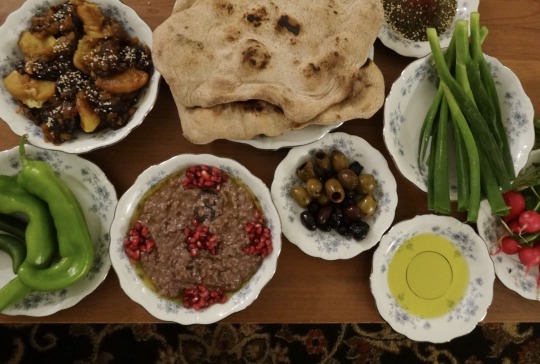
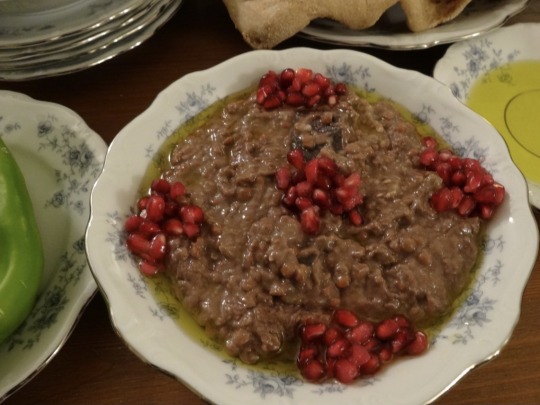
[ID: A purplish-grey stew topped with olive oil and garnished with piles of pomegranate seeds. Plates of green peppers, bitter olives, olive oil, taboon bread, green onions, radishes, and za'tar surround the dish. The second image is a close-up of the same stew. End ID]
رمانية / Rummāniyya (Palestinian pomegranate stew)
Rummaniyya (رُمَّانِيَّة; also transliterated "rumaniyya," "rummaniya," and "rummaniyeh") is a Palestinian stew or dip made from lentils, eggplant, and pomegranate seeds, flavored with nutty red tahina and a zesty, spicy دُقَّة (dugga) of dill seeds, garlic, and peppers. A طشة (ṭsha), or tempering, of olive oil and onion or garlic is sometimes added.
"Rummaniyya," roughly "pomegranate-y," comes from رُمَّان ("rummān") "pomegranate," plus the abstract noun suffix ـِيَّة ("iyya"); the dish is also known as حبّة رُمَّانَة ("ḥabbat rommāna"), or "pomegranate seeds." It is a seasonal dish that is made at the end of summer and the beginning of fall, when pomegranates are still green, unripe, and sour.
This stew is considered to be one of the most iconic, historic, and beloved of Palestinian dishes by people from Gaza, Yaffa, and Al-Ludd. Pomegranates—their seeds, their juice, and a thick syrup made from reducing the juice down—are integral to Palestinian cuisine and heritage, and images of them abound on ceramics and textiles. Pomegranates and their juice are sold from street carts and cafes in the West Bank and Gaza.
Today, tens of thousands of tons of pomegranates are grown and harvested by Israeli farmers on stolen Palestinian farmland; about half of the crop is exported, mainly to Europe. Meanwhile, Palestinians have a far easier time gaining permits to work on Israeli-owned farms than getting permission from the military to work land that is ostensibly theirs. These restrictions apply within several kilometers of Israel's claimed borders with Gaza and the West Bank, some of the most fertile land in the area; Palestinian farmers working in this zone risk being injured or killed by military fire.
Israel further restricts Palestinians' ability to work their farms and export crops by imposing tariffs, unexpectedly closing borders, shutting down and contaminating water supplies, spraying Palestinian crops with pesticides, bulldozing crops (including eggplant) when they are ready to be harvested, and bombing Palestinian farmland and generators. Though Palestinian goods have local markets, the sale of Palestinian crops to Israel was forbidden from 2007 to 2014 (when Israel accepted shipments of goods including tomato and eggplant).
Gazans have resisted these methods by disregarding orders to avoid the arable land near Israel's claimed borders, continuing to forage native plants, growing new spices and herbs for export, planting hydroponic rooftop gardens, crushing chalk and dried eggplants to produce calcium for plants, using fish excrement as fertilizer, creating water purification systems, and growing plants in saltwater. Resisting Israeli targeting of Palestinian food self-sufficiency has been necessary for practical and economic reasons, but also symbolizes the endurance of Palestinian culture, history, and identity.
Support Palestinian resistance by calling Elbit System's (Israel's primary weapons manufacturer) landlord; donating to Palestine Action's bail fund; and buying an e-Sim for distribution in Gaza.
Serves 6-8.
Ingredients:
For the stew:
1 medium eggplant (370g)
1 cup brown lentils (عدس اسود)
600g pomegranate seeds (to make 3 cups juice)
3 Tbsp all-purpose flour
1/4 cup red tahina
1/2 cup olive oil
Salt, to taste
Citric acid (ملح الليمون / حامِض ليمون) (optional)
Red tahina may be approximated with home cooking tools with the above-linked recipe; you may also toast white tahina in a skillet with a little olive oil, stirring often, until it becomes deeply golden brown.
For the دُقَّة (dugga / crushed condiment):
2 tsp cumin seeds, or ground cumin
1 1/2 Tbsp dill seeds ("locust eye" بذور الشبت / عين جرادة)
5 cloves garlic
1 green sweet pepper (فلفل بارد اخضر)
2 dried red chilis (فلفل شطة احمر)
People use red and green sweet and chili peppers in whatever combination they have on hand for this recipe; e.g. red and green chilis, just green chilis, just red chilis, or just green sweet peppers. Green sweet peppers and red chilis are the most common combination.
For the طشة (Tsha / tempering) (optional):
Olive oil
1 Tbsp minced garlic
Instructions:
1. Rinse and pick over lentils. In a large pot, simmer lentils, covered, in enough water to cover for about 8 minutes, or until half-tender.
2. Meanwhile, make the dugga by combining all ingredients in a mortar and pestle or food processor, and grinding until a coarse mixture forms.
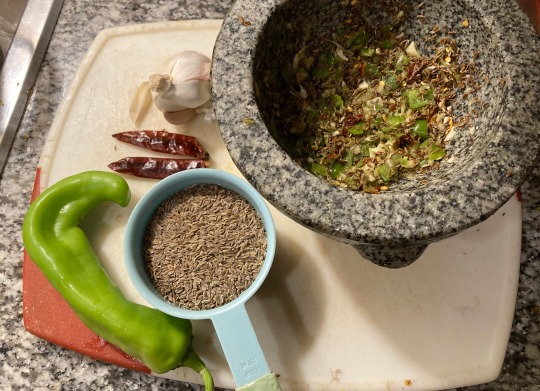
Dugga and components.
3. Cube eggplant. A medium-sized eggplant may be cut in half lengthwise (through the root), each half cut into thirds lengthwise, then cubed widthwise.
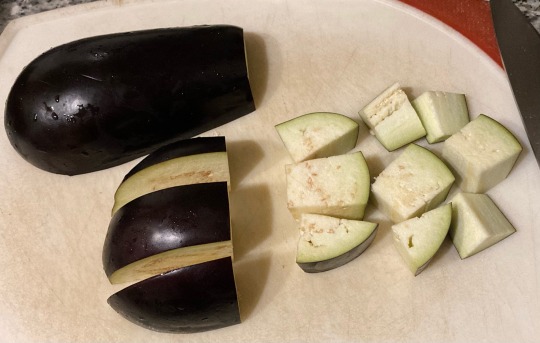
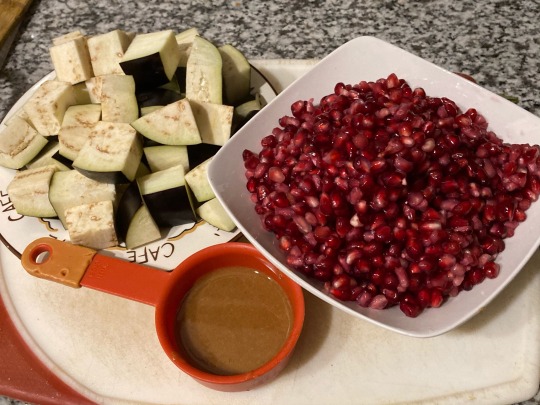
Cubed eggplant, red tahina, and pomegranate seeds.
4. Add eggplant to simmering water (there is no need to stir).
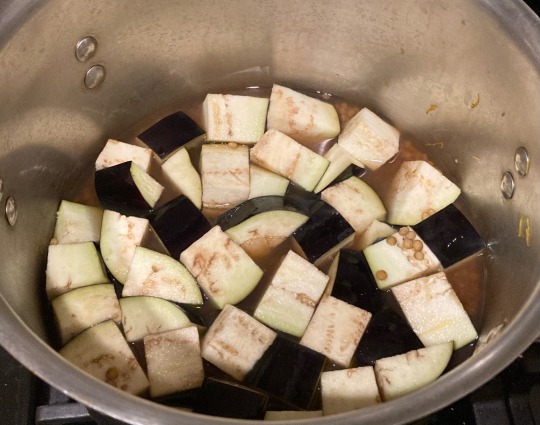
5. While the eggplant cooks, blend pomegranate seeds in a blender very thoroughly. Strain to remove any gritty residue. Whisk flour into pomegranate juice.
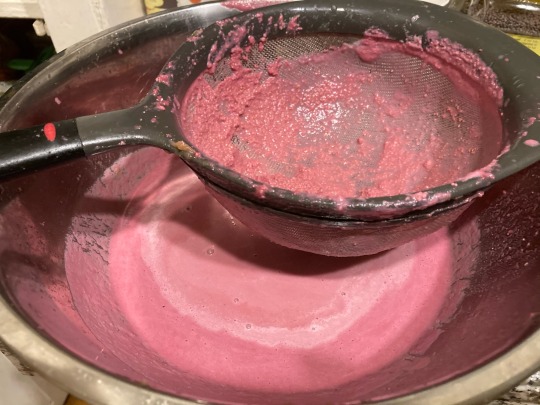
Pomegranate juice being strained.
6. Taste your pomegranate juice. If it is not sour, add a pinch of citric acid or a splash of lemon juice and stir.
7. Add dagga to the pot with the lentils and eggplant and stir. Continue to simmer until the eggplant is very tender and falling apart.
8. Add pomegranate juice, tahina, and olive oil to the pot, and simmer for another 5 minutes, or until stew is very thick and homogenous.
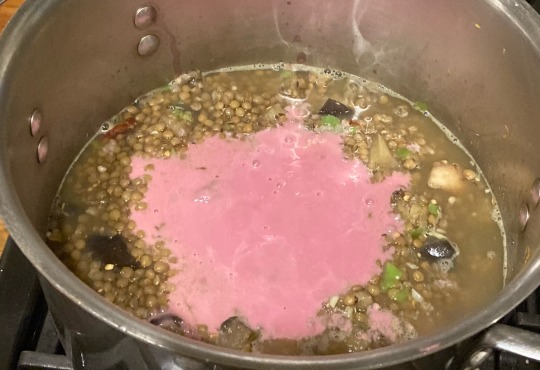
Bright pink pomegranate juice in stockpot.
9. (Optional) In a small skillet, heat a little olive oil on medium. Fry minced garlic, stirring constantly, until golden brown. Add into the pot and stir.
10. (Optional) Mash the stew with the bowl of a ladle or a bean masher to produce a more homogenous texture.
Serve rummaniyya hot or cold in individual serving bowls. It may be served as an appetizer, or as a main dish alongside flatbread, olives, and fresh vegetables such as radishes, green peppers, green onions, carrots, and romaine lettuce. It may be eaten with a spoon, or by using كماج (kmāj), a flatbread with an internal pocket, to scoop up each bite.
572 notes
·
View notes
Text
julia posts shit on her story like "reminder to fuel your body with whole, nutritious foods! here's my inner-soul-healing vitamin-filled energising lift-your-mood green smoothie made with homegrown silverbeet, locally sourced dandelion root and lemon balm from the farmer's market, raw copper, ethically sourced seaweed, and lentils!" and MK reposts it with the caption "this bitch just downed 2 cans of monster, a bag of extra hot takis and then hit her vape right in front of me"
#they are so stupid. you can bet julia was SO mad at her#mk julia#mk total drama#julia total drama#total drama#mkulia total drama#mkulia
196 notes
·
View notes
Text
How to follow a Mediterranean Greek diet
The Mediterranean diet naturally expands throughout the coastal countries of South Europe, North Africa and the Middle East but there are some small differences between their cuisines. So here I am writing specifically about the Greek version of the Mediterranean diet, known for its delicious, natural flavours and its significant health benefits.

Eat daily:
Olive oil: the pillar, the liquid green gold of the Mediterranean Greek diet. Olive oil should be used ideally exclusively for all purposes. It's dressing salads, it's used in cooking and in fact it's traditionally what is used in frying too. Replace all types of oils, butter and margarine with olive oil even when making pastries. The only problem here is that outside of the Mediterranean basin olive oil can be pricey, however that's the foundation the diet is based on. If you are interested in following the traditional Greek diet for taste or health purposes, it is good to really incorporate olive oil in your daily cooking. If it’s not possible to afford buying olive oil all the time (although you could balance it out by not buying other oils and butter), a non-Greek-typical but equivalent alternative could be avocado oil. However, I doubt avocado oil or any other oil can remotely compare to olive oil in health properties, taste or in any other positive quality 🫒
Vinegar: Just like olive oil, vinegar is a very important ingredient and is also used in natural remedies However, it can hurt a sensitive GI tract if consumed in large portions. A little bit of it added to meals frequently is very healthy. Apple cider vinegar is also very loved and used in salads often 🍇
Vegetables: no portion can be too much (wild greens, garlic, onions, cauliflowers, cucumbers, eggplants, beets, peppers, spinach, artichokes, zucchini, peas, lettuce, the list never ends). Tomatoes and broccoli are recent additions to the Greek diet however they were integrated perfectly to the Greek cuisine. In general, all vegetables can be enjoyed freely with some moderation in the potatoes, especially when fried 🥗
Fruits: grapes, berries, apples, melons, cherries, figs, prunes, sour cherries, peaches, pomegranates are the most historically loved fruits in the Greek diet. Since the middle ages citruses like the orange, the lemon and the mandarin are more and more loved. Greeks nowadays use lemon almost more than vinegar and both have become integral components of the Greek diet. Obviously, tropical fruits like, say, banana, mango, grapefruit are not present in the traditional Greek diet, however all fruits are good fruits and you can enjoy them freely 🍎
Legumes. Eat freely to the tolerance of your body. Legumes can be too heavy for some GI tracts. Legumes are a great source of protein and fibre. Choose brown lentils, white beans, fava beans, chickpeas, giant beans and black eyed peas the most 🫘
Nuts, seeds: almonds, walnuts, sunflower seeds, peanuts etc. Eat as much as your body can take, because everybody is different 🥜
Mushrooms: mushroom it up! A great healthy way to have them is grilled with herbs and plain or apple cider vinegar dressing 🍄🟫
Whole grains: this is the traditional way to eat grains. Brown bread, oats, whole wheat pasta 🌾
Fish and seafood: find and eat them fresh. Instead of buying them deep frozen from the big markets, find local fish stores if your place is coastal and has them. Eat both large but especially small and medium sized fish. Some fish like salmon and tuna should ideally not be consumed daily due to their high levels of mercury and fats 🐟🎣🍤
Herbs and spices. Feel free to use as much as you want however if you are interested also in the flavours of the Greek diet besides the health benefits, a tip is that Greek dishes do not contain extremely hot spices 🌿
Water: A lot of water daily and, mind you, plain clear mineral water. No flavoured water, definitely not sparkling water and ideally no other liquids in place of the water. I mean, sure you can have liquids but you should ALSO have plain water 💧
Eat a few times per week:
Poultry: Poultry and lean meats entered the Greek cuisine mostly after the Middle Ages however they are nowadays enjoyed as part of the Greek Mediterranean diet because they are tasty and healthier than other types of meat. Chicken has become especially popular in the Greek cuisine. Other birds are the pheasant, the quail, the turkey and more sparsely the duck 🍗
Eggs: eggs are healthy and should be consumed a few times per week but not daily because they can cause a rise in cholesterol levels 🥚
Dairy: Greeks LOVE dairy products, especially the various types of cheese, however they are often irritating to the GI tract and they are linked with rises in the level of inflammation in the body. This is why you should ideally limit them to a few times per week. One exception is the yoghurt, which is fermented and can be perhaps consumed more frequently due to its beneficial properties. Important note: if you want to follow the Greek diet, you should ideally opt for milk and other dairy products from goats and sheep! Cow milk is not traditionally used in the Greek cuisine often and sheep and goat milk are significantly healthier and more nutritious. The only drawback is the stronger smell, however if you can get past that, it is strongly advised to switch to those instead of cow milk. Another note: what is known as “Greek yoghurt” in western countries is not in fact a true Greek yoghurt. What you call Greek yoghurt is to us simply a strained yoghurt, a yoghurt from which the whey has been removed. Sometimes in western markets (and in Greek “modern” dessert yoghurt products) butterfat and powdermilk is added to them and they are mostly made of cow’s milk. Again, a traditional Greek yoghurt is made of sheep, goat milk or a mix of both and is unstrained. It also has a trademark thickened skin on its top (dunno if this is the actual term lol) which is in fact the part of the yoghurt that contains the most nutrients and personally it’s the tastiest part of the yoghurt but apparently it is not for everyone. As an example, a study showed that an unstrained sheep yoghurt has more protein, more omega-3 fatty acids and minerals yet fewer calories and fats than a strained cow yoghurt 🍦🧀
Wine: in small portions, like a small glass up to a few times per week and always in combination with your meal. You don’t drink it to get hammered, you drink it for the health benefits it has in very moderate quantities and for the reasonable mild euphoria it causes before it becomes harmful. The GI tract is linked to the brain and is detrimentally influenced by negative emotions. This is why it is important to try to be in a good mood, relaxed and peaceful when you sit down to eat. A sip of wine now and then can be good for that 🍷
Eat once per week or ideally less:
Red meat like pork or beef. In fact, beef should be the one most avoided not only because it is indeed the rarest of the common meats used in traditional Greek cuisine but also because you can’t separate the fat from the meat as easily as with pork. To follow the Greek style in a healthy way opt for goat, then lamb or pork and make beef your most occasional meat dish 🥩
Processed meats should be eaten rarely. If you are in a mood for it though, opt for Greek style sausages with herbs in or bacon at most. Cured meats like ham are better to be avoided but turkey is the healthiest of them. They are not a part of a traditional Greek cuisine though.
Refined grains can be enjoyed weekly but should not replace whole grains
Pastries. What’s new, pastries are not ideal for health. However, if you are yearning for something sweet, if you want to keep it healthy as much as possible in the “Greek way”, opt for desserts made of healthy ingredients like honey, nuts, olive oil and fruits. Chocolate came to Greece in the 19th century, however it has become an integral part of confectionery since then. Opt ideally for dark chocolate, combined with nuts or fruits such as oranges and prunes. Greeks especially love chocolate combined with nuts.
Soft and sugary drinks. Avoid them overall, especially the processed products in the markets. If you need a sweet drink really bad, you can keep it traditional by making your own sweet lemonade, sour cherry, pomegranate etc drink at home. You could also enjoy small quantities of lemon or mastic liquors which are good for digestion.
BONUS TIPS & PHILOSOPHY:
Try to find mastic if it’s available where you live. The mastic is a resin produced from the mastic tree, a species endemic to the Greek island of Chios and a small part of the opposite coast of Turkey. It has numerous beneficial properties, especially for digestion and gut health, and it combines them with a very pleasant fresh and sweet flavour. You can find it in gums that boost digestion, in drinks, in pastries and even in non-edible products like toothpastes. Learn about it and give it a try, no matter if you are interested in following Greek diet or not.
Greek cuisine does not go berserk on as many ingredients as possible (however Greeks typically add more ingredients than, say, Italians and perhaps fewer than the Middle Easterners). Don’t worry about adding as many foods and nutrients in one single dish. The most important thing in Greek cuisine philosophy is to pick the finest ingredients. Avoid deep frozen or precooked and processed ingredients. Pick whole fruits and vegetables from your local small grocery store. For example, don’t buy a watermelon slice in a zelatin bag from the supermarket. Take the whole freaking watermelon home. You heard me right. It’s heavy, yes, but you would be surprised how much tastier and healthier it is this way. Go to the butcher for meat. Go to the specific cheese shop for cheese. Go to the fisherman for fish and seafood. Go to the pastry shop and get a nice dessert instead of buying candies from the market.
Remember that in moderation you can eat most of the foods you desire, especially if they are not processed foods. There is nothing about the Greek diet that is restrictive in terms of its philosophy - historically the intake of various foods was regulated only based on availability and price. There are no foods you should limit due to any perception of them being “bad” and you should never feel guilty the moment you are actually having the food. Just work slowly and progressively by building gradual appreciation for healthy foods and prize less nutritious foods as occasional taste bud rewards.
As said above, a good mood is crucial when you sit down to eat. In the history of the Greek society this translated into eating with friends and / or family, maybe with the occasional sip of wine, ideally in a pleasant environment and always taking your time with your food. If some of these are less feasible than others, try alternatively to improve the setting in which you eat, to eat in an environment that calms you down. Schedule your meal so that you won’t eat in anxiety or hurry, if this is possible. Think of pleasant memories and feel grateful for your food. Cheers! Or, you know, εις υγείαν!
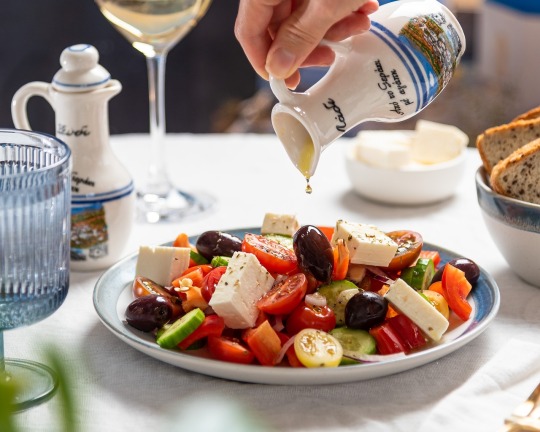
101 notes
·
View notes
Note
Ozzie back here again to add to the idea of how much König needs to eat a day, here are a few suggestions that I can imagine he does to make his great need for food easier to handle (this is based on my own experience and the experiences of the other people at my gym and old veterans at my favourite pub so do not use this for in real life as this is just to help imagine how König eats and lives)
So, from what I know from the veteran I have made friends with, when he was in the military, they had a focus on foods that provided them with a great amount of energy, protein, iron, zinc, and vitamins C and D as it was the nutrients that they tended to run out of the most but it also the ones with some of the greater consequences with diseases that can make them weak and cause their immune system to be weak. Soldiers also eat a lot of protein as it is believed to help them grow their muscles more quickly. This makes me believe that König would focus on foods that provide him with a lot of nutrients but mainly protein to grow his muscles but not too much protein as he does not want to get sick and to build the balanced diet needed for his lifestyle
Some great food options for him would be many vegetables and fruits but for protein, I would suggest things such as eggs, poultry, beans, lentils, fish, nuts, chickpeas, yoghurts, and cheeses, I tend not to suggest red meats unless they are very lean due to the amount of fat in them and not being fond of the texture but I imagine König to enjoy them so if you were to make him food I would include things such as those along with some form of starch/carbohydrate by giving him some pasta, rice, bread, or potatoes which can help fill him up faster without him overeating and if they are reheated they will get resistant starch
I imagine König lives in the Alps so that he can be away from people and enjoy nature but I also imagine him earning a lot of money due to his job, putting his money into stocks/businesses, some dodgy dealings, and saving it up as he had no reason to spend most of it which means he could buy a lot of land. With this large amount of land, I imagine him using it to have his own giant garden with some animals, as it means he has to deal with fewer people to get what he needs. The garden would probably be made up of an orchard with trees of his favourite fruits but it would mainly be patches of vegetables and fruits while for his animals it would make sense for him to have chickens as he probably needs a lot (and I mean a lot) of eggs so having chickens make it a lot easier
If he can not grow it on his own land, he would probably hunt or forage it, which means that he can get his energy and murderous tendencies out that would normally be taken out on the field while still getting some food out of it (but it sadly makes him more hungry). But if it is a certain food like milk or cheeses or yoghurts he will most likely just go down to the local markets in the nearby towns and villages so he can get fresh items from people he trusts
Now we know some information about where he gets the food from we need to know where you would be cooking and keeping it. An appropriate and smart option would be to have a walk-in freezer in his basement that he can use to store the great amount of meats he has that has a wine/alcohol storage opposite it. While the kitchen would probably be massive and fully decked out with anything you need to be able to cook and two or three double-door fridges that are filled with any item that needs to stay chilled in it, although the cabinets are mostly up too high for anyone to reach without a stool unless you are König but they are filled to the brim with sweets as the giant has a sweet tooth to match his size or the weird collection of novelty cups he has collected from places he has went on missions too or beer glasses from different bars or pubs
If you were to cook food for him batch cooking (so you do not keep having to cook again and again) would be the best option with foods that are traditional to Austria or hearty foods like stews that can be cooked in large amounts with lots amounts of meats and vegetables (I can give a whole list of foods I recommend or I think he would like if you want them)
As you can tell I have too many ideas about this and I have way more because this has inspired me, and thank you for reading this long rant that probably does not make any sense
I love this so much 😭 The sweet tooth headcanon, his collection of beer glasses and such, him living in the Alps and hunting some of that precious protein... This screams Cabin/Off the grid König to me, I would make a cute garden for him to get those veggies stocked and stashed to some root cellar like this:
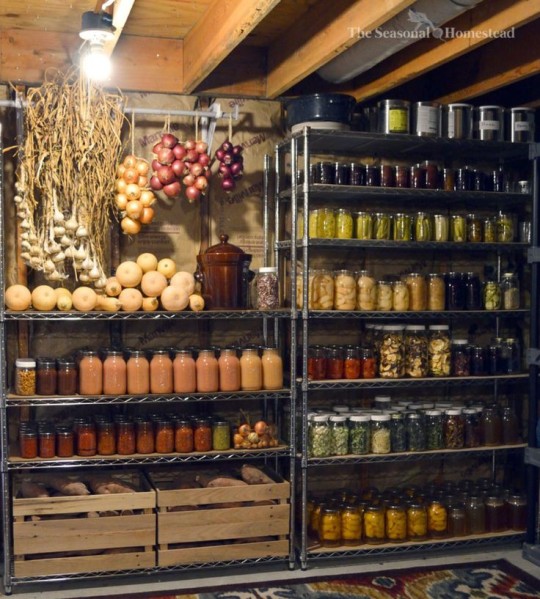

And then I'd probably spend the rest of my time here, cooking those hearty stews for him:

#feeding König#könig headcanons#I'm utterly shameless about wanting to take care of this man's EVERY need#long post#tw: long post
118 notes
·
View notes
Text
18 Plant-Based Protein Sources
Protein is often raised as a concern for people considering adopting a plant-based diet, and because we’ve all been taught to associate protein primarily with red meat, this is not surprising.
It is estimated that most adults require a minimum of 56 grams of protein per day; you’re probably hitting that number now if you’re not in a calorie deficit. If you’re trying to lose weight and so are cutting calories then you may need to track your protein a little more closely, but 56 grams is very easy to hit without having to think about it.
It gets a bit more difficult if you’re very physically active, particularly if you’re engaged in regular endurance or strength training. There is a great deal of disagreement about precisely how much protein is ideal if you’re trying to build muscle, but 1g of protein per 1lb of bodyweight is very doable, which is the amount often recommended in bodybuilding circles. It is very achievable to hit even the upper end of protein requirement estimates using only plant-based foods, as demonstrated by the success of many vegan athletes. Listed below are particularly good options.
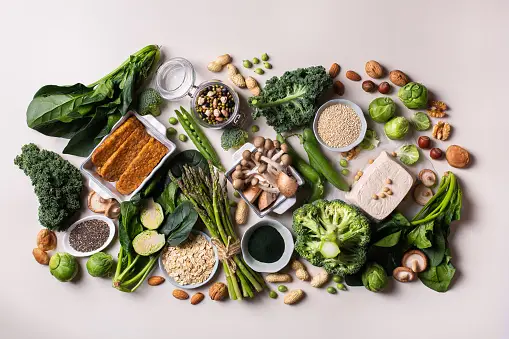
1) Lentils - Lentils are a cheap nutritional powerhouse, and provide about 17 grams of protein per cup. They’re also very flexible, you can have them as your main protein source of a meal, use them to substitute mince in a pasta dish, make burgers out of them, or put them in a stir fry or with rice and veg with some seasonings. They are cheap and convenient if you buy them canned, since they’re ready to eat, though I would recommend at least warming them up.
2) Chickpeas - Chickpeas are a popular vegan staple, and it’s not hard to see why. At approximately 14.5 grams of protein per cup, they’re nutrient-dense and very flexible. Use them to make hummus or falafel, as the main protein source of a curry, on their own with rice or worked into a salad. You can also just air fry/grill them with some oil and spices for a convenient, crunchy snack.
3) Oats - A cup of dry oats is around 11 grams of protein by itself. Making it with a cup of oat milk brings that up to 14 grams, throw in a tablespoon of peanut butter and you’re up to about 17.5 grams at breakfast, and all those ingredients are pretty cheap and very filling. You could add something like nuts or chia seeds as a topping to stretch that to well over 20 grams.
4) Nuts - Peanuts are 9.5 grams per ¼ cup, almonds are 7g, pistachios 6g, cashews 5g, hazelnuts 5g, brazil nuts 4.75g, walnuts 4.5g and pine nuts are 4.5g. You can buy 1kg bags of mixed nuts for a little bit cheaper and keep them in a jar for a healthy snack. I find it better to make your own mix, or buy a mixed bag that doesn’t have peanuts in then add the peanuts later, as mixes that include peanuts tend to work out as less for your money. Peanut butter is also a cost-effective way to add protein to many snacks and meals.
5) Beans - Depending on the type, beans are anything from around 10-15 grams of protein per cup. Some are better than others, like kidney beans, but even your standard baked beans are high in protein and very good for you. Turn them into a chilli, have them on toast, on a jacket potato, turn them into a bean burger or make them the protein base of a salad or soup. Kidney, soy, and edamame beans are particularly good options.
6) Seitan - When cooked, seitan closely resembles to look and feel of meat. It is made of wheat gluten and has 25 grams of protein per 100 gram serving. It is not very widely available in supermarkets, but try your local Asian market, where it will usually be cheaper as well. It’s a bit of a hassle, but you can also make your own at home, which is extremely cheap as it’s just wheat gluten, yeast, plant milk, miso, and spices.
7) Tofu/Tempeh - A staple in Asian cooking, don’t be afraid to try this one. Think of it as doing all the same things chicken does in terms of recipes, it soaks up the flavour around it. It needs to be pressed before use, or you can avoid that by just freezing it, then thawing overnight when you want to use it. 100 grams of tofu (less than half a small block) contains about 12g grams of protein, depending on the type. Some tofu, like Naked TooFoo, is pre-pressed for you.
8) Soy Chunks - Soy chunks come in a pretty unappetizing form that looks a bit like dried dog food. Just soak them in lightly salted hot water or vegetable stock for 15 minutes and they'll come to life, behaving like faux chicken pieces. You can then just cook, fry or bake them as you would with any soy product or tofu. They're much like tofu in that they'll soak up whatever sauce you cook them in. They're extremely cheap, have an amazing shelf life, and are a whopping 50g of protein per 100g. This is what I use to make the equivalent of that 'chicken, broccoli, and rice' meal high-protein meal that bodybuilders love so much.
9) Faux Meats - Faux meats are an easy way to add a protein base to your meal, and have the advantage of serving the same function on a plate as the foods you were used to before you went vegan. A Beyond burger, for example, has 19g of protien per patty, though you can get much cheaper options that have a similar nutritional profile. Pair that with a wholemeal bun and something like brown rice/quinoa and vegetables and you can create a very high-protein meal.
10) Grains - All grains are good for protein, these include quinoa, spelt, brown/wild rice, teff, amaranth, and sorghum. They can range anywhere between 5 and 8 grams per 100 grams, and you’ll usually be serving them with some sort of protein source. They’re also an excellent source of fibre and carbohydrates, which are also important for training and general health. Quinoa in particular provides all 22 essential amino acids.
11) Peas - Green peas are not mentioned much when it comes to high protein options, but a cup of cooked peas is a respectable 9 grams of protein, and it’s worth mentioning here because they tend to be used more as a side than main, so can be paired with other high protein options. They’re also very cheap, freeze well, and are easy to prepare.
12) Seeds - Just a tablespoon of chia seeds is nearly 3 grams of protein, and the seeds are so small and tasteless that you don’t actually notice them in anything you put them in, making them an easy way to add protein to just about any meal. They’re pretty cheap to buy in large quantities, particularly good to replace eggs in baking, to add to bread flour, salads and oatmeal. Other high-protein seeds include pumpkin, sunflower, linseed, hempseeds, and buckwheat.
13) Bread - Bread may not immediately come to mind when you’re thinking about protein, but wholegrain/rye/spelt breads can be very high in protein, anywhere from 3g all the way up to around 10g per slice, particularly for seeded loaves. If you really want to turn bread into a high protein food, invest in a bread maker or bake it yourself, that way you can add nuts, seeds and oats yourself to up the nutritional value. That’s just the bread too, a hummus and falafel sandwich with a high protein bread can be very nutritionally dense.
14) Fruit and veg - Worth mentioning here, as they’re something you’ll need to consume to maintain a healthy diet anyway, and some options have moderate protein. The higher protein options include broccoli, spinach, asparagus, artichokes, potatoes, sweet potatoes and Brussels sprouts, which all contain 4–5 grams of protein per cooked cup. Likewise, blueberries, guava, bananas and nectarines contain about 2-4 grams of protein per cup, as well as many other essential vitamins.
15) Nutritional Yeast - No vegan list is complete without mentioning it, it’s a vegan staple for its nutty, cheesy flavour, as well as being an easy source of vitamin B12. It’s a complete protein that has 8 grams of protein per 16 grams serving, making it an easy way to add more protein to things like pizza, pasta dishes, or a jacket potato. Use it to make cheesy sauces, or just sprinkle it on anything you’d have previousy added parmesan cheese to.
16) Protein Bars - They tend to be on the expensive side, but there are a few plant-based options. I’d recommend Misfit bars if you can get them online, they’re low sugar, 15g of protein per bar, and you can buy them in variety packs of 40 which works out cheaper. Trek also has protein flapjack bars, they're less protein (8-9g) but are much cheaper in packs of 3 and frequently available at a discount. Check your local health stores for their own brand versions too, some are very good.
Most brands won’t be suitable as a daily option for many people given the price, but they're great for when you need something to sate your hunger on the go when you'd usually reach for a chocolate bar or junk food. You can also just make protein bars at home using nothing but oats, cinnamon, baking soda, a little maple/golden syrup, and a couple of scoops of plant-based protein powder.
17) Protein Powders - If you're trying to substantially increase your protein but don't want to eat high quantities of food, protein powder will help you out Even the cheaper powders are around 18g of protein per scoop, so a shake is an easy way to add more protein to your diet, or you can stir it into oatmeal to get most of your daily requirements over breakfast. Add some peanut butter, chia seeds, a banana, and some plant milk to a shake to make them tastier and more nutritionally dense. I use the vegan protein powder by Protein Works, because I like the taste and the high-quality protein sources they use. There are plenty of other good (and cheaper) options on the market, though.
18) Meal Replacement Powders - Some meal replacement shakes, like Huel Black, are around 40 grams of protein per serving (2 scoops) even when made with just water, providing a cheap and easy way to have a high protein and nutritious meal without any preparation or fuss. This is the one I use, but a lot of the diet and meal replacement shake options are vegan and are generally high in protein. If you're trying to just add protein then a protein shake will be more cost-effective, but as a high protein replacement for an actual meal, they are good to have around. Note: I don’t accept sponsorship or commissions from any brand and I don’t have any affiliate links. Any product recommendations are based solely on my own experience.
151 notes
·
View notes
Note
hi (waves) as a fellow eater of vegetarian glops, would you be interested in some of my favorite one pot recipes? I've got recipe for pasta with chickpeas I particularly like, a really nice red lentil/sweet potato glop, and a no chicken no noodle no soup.
Please! Always in the market for new recipes, and-okay 2/3 of those sound delicious, the no soup I'm mostly just curious about.
53 notes
·
View notes